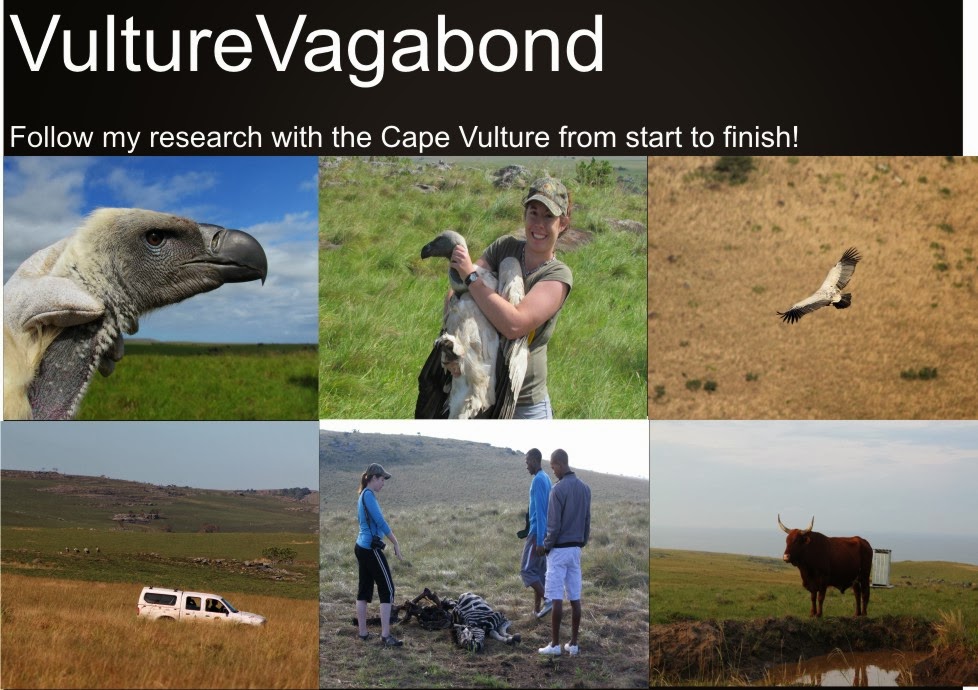 |
| Pure Joy! |
That is what we caught this past week during the second
Mkambati vulture capture. Long story short, one of the GPS transmitters was not
working correctly on our previous trapping trip. We decided not to put that
unit on a bird. Therefore, I needed to organize another trapping trip to deploy
a replacement unit as well as three units from Avi-Track.
After months of planning, the week of the capture was upon
us. My team stayed at Riverside Lodge, which is located on the ocean at
Mkambati Nature Reserve. It is large enough to hold 20 people; however it is
about a 30-45 minute drive to the vulture trap. We needed to be in the hide at
the vulture trap before 5:45AM. Talk about a morning commute!
We did that morning commute three days in a row with no
success. Two team members and I sat in the hide, quiet and patient. The hide is
in the shape of a triangle and is covered with multiple layers of green shade
cloth. I was quite tired of triangles and the color green after three days.
The vultures were not playing our game those first three
days. First of all, the wind was gusting up to 12 kph or 7mph. The birds would
circle over the trap with the freshly dead zebra (which was procured by yours
truly – stayed tuned for that adventure!) Some even landed on the ground! On
the ground, on the complete opposite side of the entrance to the walk in trap.
And the peak of frustration was when the vultures were perching on top of the
trap for hours looking down at the free meal! We were having luck attracting a
Fish Eagle (Haliaeetus vocifer).
While feeding on the carcass, it would chase the Cape Vultures away!
 |
| Vultures on the trap, while we sit in the triangle hide to the right. |
One the fourth day, which was Sunday March 17th,
the celebration of St. Patrick, we caught the birds! We had placed another dead
zebra inside of the trap, while the previous zebra was placed in front of the trap
door. The vultures were on the zebra outside of the trap by 6:20AM making their
guttural noises as they gorged themselves and put the Fish Eagle in his place. The
eagle saw the dead zebra inside of the trap and went to feed on it. The
vultures finished off the zebra outside, and the mob began to inch over to the
trap where the fish eagle was eating. At
this moment, I was so nervous. At any moment the vultures could be scared off
and not come back for another day. On top of that, members of my team had to
leave that day. So the pressure was on!
The vultures’ instinct took over and a group of 20 birds
were feeding happily in the trap, while more were waiting to get in. That is
when we pulled the curtain closed and successfully caught 25 Cape Vultures and
that pesky Fish Eagle!
On closer expectation, we re-trapped one of the birds from
the November trapping trip. This was great because I had already collected the
measurements from this bird. That bird was then fitted with a GPS transmitter.
In total we wing-tagged 24 Cape Vultures and deployed four
GPS transmitters. I have a total sample size of nine adult vultures with
transmitters and 34 wing-tagged birds. The following day at the vulture colony,
we re-sighted 16 of the birds! I look forward to following the movements of the
birds as well as their journey through the breeding season.
I would like to say thank you to the team that helped with
this capture. It was truly a magical
week!
 |
| The men making a plan! |
 |
| One of the vultures being fitted with a transmitter. |
 |
| Taking measurements of the dangerous part! |
 |
| A vulture with a transmitter being released. |
 |
| The group with the trap, ocean, and a vulture in the background. |















